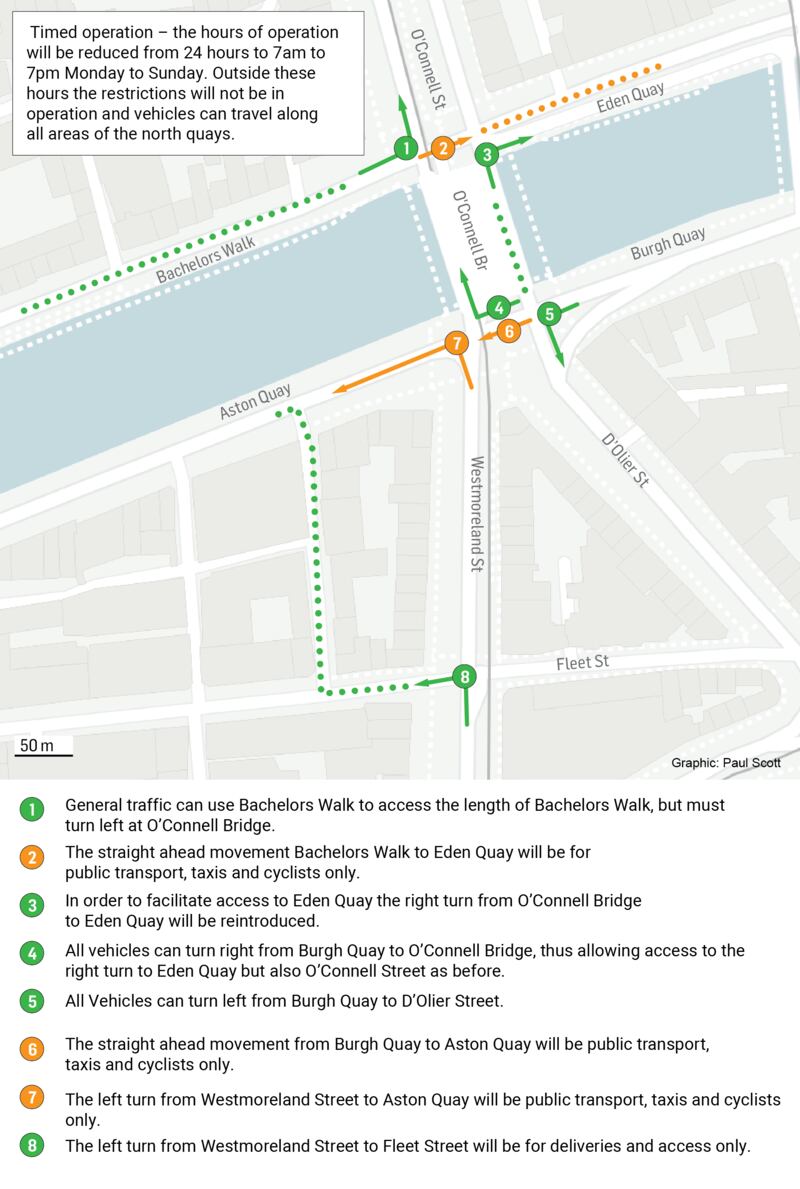Traffic restrictions due to come into effect in Dublin city centre next month have been considerably watered down, with motorists facing fewer curbs on access to the city quays than planned.
The Dublin City Centre Transport Plan, published last year, included 24-hour “bus gates” on Bachelors Walk and Aston Quay restricting passage to public transport only.
On the northside it was intended traffic would divert from the quays on to Jervis Street. However, councillors were on Monday told the plan had been amended, allowing motorists continue along Bachelors Walk and turn left on to O’Connell Street.
The only new restriction on this side of the river would be going straight ahead from Bachelors Walk on to Eden Quay, which will be for public transport only. Private cars are already banned from turning right on to O’Connell Bridge from Bachelors Walk.
On the southside the plan does not permit motorists to drive straight from Burgh Quay to Aston Quay, but it was never planned they would be banned from turning right from Burgh Quay on to O’Connell Bridge to reach O’Connell Street. In a new concession, motorists coming from Burgh Quay will also be permitted to turn right from O’Connell Bridge to reach Eden Quay.
The Aston Quay restriction also applies to traffic coming from Westmoreland Street, with only public transport allowed to turn left on to Aston Quay. However, Dublin City Council has now clarified, private traffic on Westmoreland Street will be able to turn left at Fleet Street into the Temple Bar area for “deliveries and access”.
However, this will allow motorists to return to Aston Quay at Price’s Lane, which will mean just a very short section of the south quays, about 50m, will be free of private traffic.
In addition the council has decided all measures will apply from 7am-7pm only.

These changes to the transport plan, which Dublin City Council chief executive Richard Shakespeare referred to as “minor tweaks”, were arrived at after consultation with disabled persons’ organisations who had, some months ago, raised concerns about their ability to access the quays by private car.
However, they should go a considerable distance to satisfying the concerns of businesses, who last week met Mr Shakespeare, council head of traffic Brendan O’Brien, and National Transport Authority deputy chief Hugh Creegan, following the intervention of Minister of State for Enterprise Emer Higgins.
On Monday Mr Shakespeare told councillors he had been asked to delay the implementation of the plan from August to “March or April 2025” and to consider an economic impact study on the plan commissioned by the City Centre Traders Alliance.
A spokesman for the council on Tuesday said Mr Shakespeare had yet to receive this study, but would decide within the next “two-three weeks” whether to change the implementation dates.
Councillors, the vast majority of whom support the plan, were on Monday outraged, not by the revisions to the plan, but by Ms Higgins’ intervention, and that Mr Shakespeare might consider delaying the plan at the behest of “big business”.
They are, however, powerless in this matter. Traffic management measures are the responsibility of the council management, under the Roads Traffic Act, and not councillors.
However, councillors may have nothing to fear; the revisions announced on Monday mean these are now minor traffic management measures of the routine sort the council undertakes periodically to ensure the smooth running of public transport, such as the Luas.
The revisions in particular mean car parks represented by the traders’ alliance, such as the Arnotts or Fleet Street car parks, would see no alterations to their access routes. In total only three buildings on the 50m stretch of Aston Quay would not have direct private vehicle access, from 7am-7pm.
These alterations should allay traders’ fears and make any delay to the implementation of the traffic changes unnecessary.
- Sign up for push alerts and have the best news, analysis and comment delivered directly to your phone
- Join The Irish Times on WhatsApp and stay up to date
- Listen to our Inside Politics podcast for the best political chat and analysis










